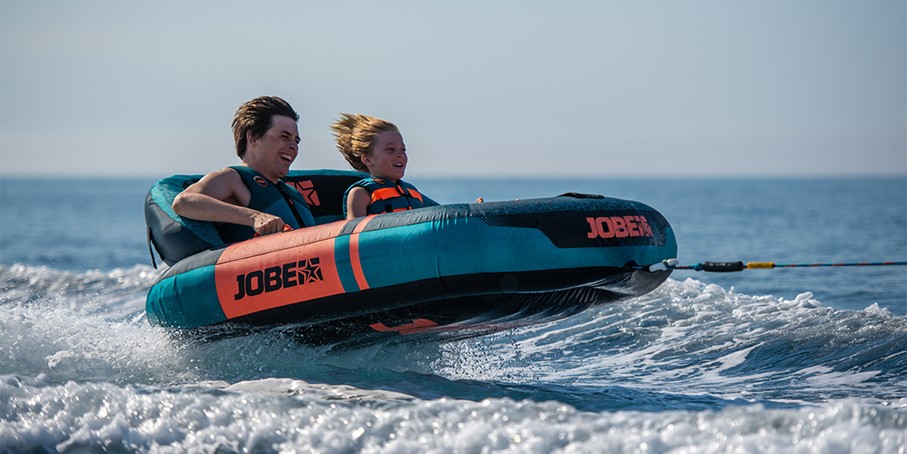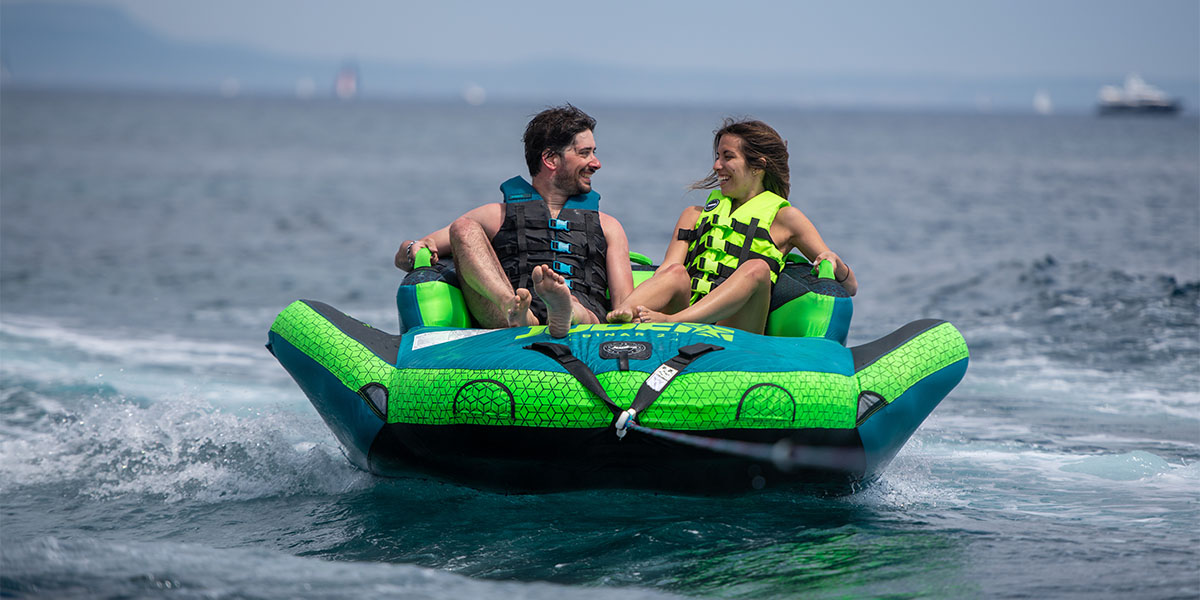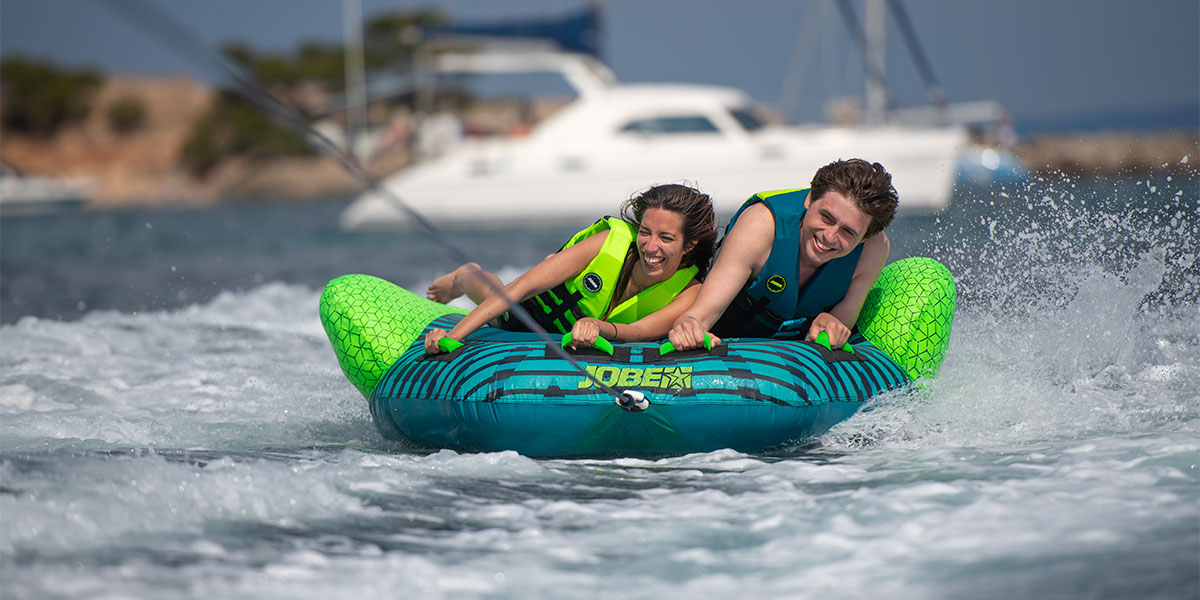Towables: The Ultimate Guide (2023)
Are you ready for some serious fun on the waves? If you're looking for an adrenaline-fueled adventure that's sure to get your heart pumping, then look no further than towable tubes! Whether you're a seasoned pro or a first-time rider, towable tubes are a great way to experience the thrill of being towed behind a boat. With so many different types of towable tubes available on the market, from single-person tubes to multi-rider options, there's something for everyone. So, buckle up and get ready for an exciting ride as we explore everything you need to know about towable tubes behind a boat!

How to inflate towable tube with air compressor?
To inflate a towable tube with an air compressor, you will need a compressor with a hose and an inflator nozzle that is compatible with the valve on your towable tube. Here is a step-by-step guide on how to inflate a towable tube with an air compressor:
- Make sure that the air compressor is turned off and unplugged before attaching the hose and nozzle to the compressor.
- Locate the valve on the towable tube and make sure it is in the open position.
- Attach the inflator nozzle to the hose, making sure it is securely fastened.
- Place the nozzle over the valve on the towable tube and press it firmly against the valve to create a seal.
- Plug in the air compressor and turn it on.
- Adjust the air pressure on the compressor to the recommended level for your towable tube. This information can usually be found on the towable tube itself or in the manufacturer's instructions. Generally the maximum amount of pressure is 0.19 bar or 2,7 PSI.
- Monitor the pressure gauge on the compressor to ensure that the towable tube is being inflated to the desired level.
- Once the towable tube is fully inflated, turn off the air compressor and unplug it.
- Remove the inflator nozzle from the valve on the towable tube, making sure to close the valve before removing the nozzle.
- Double-check the pressure in the towable tube to make sure it is at the recommended level. If necessary, add more air using the air compressor until the desired pressure is reached.
It is important to follow these steps carefully to ensure that your towable tube is inflated properly and safely. Always make sure to read and follow the manufacturer's instructions for your towable tube and air compressor, and never exceed the recommended pressure levels.
How to deflate towable tube?
To deflate a towable tube, you will need a valve tool or a deflation nozzle, depending on the type of valve on your towable tube. Here is a step-by-step guide on how to deflate a towable tube:
1. Locate the valve on the towable tube. Towable tubes typically have one of two types of valves: a Boston valve, speed valve, stem valve or a Halkey-Roberts (HR) valve.
2. If your towable tube has a Boston valve, you will need a deflation nozzle to deflate it. To use a valve tool or deflation nozzle, simply insert the tool into the valve and turn it counterclockwise to open the valve, with Jobe tubes this can be done by hand. The air will then begin to escape from the towable tube.
In short:
- Halkey Roberts: press and turn
- Boston Valve: unscrew both caps by hand
- Speed valve: pull out both caps
- Stem valve: pull out the cap and squeeze to deflate
3. Once the towable tube is fully deflated, make sure to close the valve before storing or transporting the tube. This will help to prevent air from re-entering the tube and causing it to partially re-inflate.
It is important to follow these steps carefully to ensure that your towable tube is deflated properly and safely. Always make sure to read and follow the manufacturer's instructions for your towable tube, and be sure to use the appropriate valve tool or deflation nozzle for your specific type of valve.
.jpg)
How to store a towable tube?
To store a towable tube, you should follow these steps:
- Clean the tube thoroughly, using a mild soap and water. This will remove any dirt or debris that may have accumulated during use.
- Dry the tube completely using a towel (tube must be 100% dry). This will prevent the tube from developing mold or mildew while in storage.
- Check the tube for any damage or wear and tear, and make any necessary repairs before storing it.
- Store the tube in a dry, cool place, out of direct sunlight. A garage or storage shed is ideal.
- If you have limited space, you can use a storage bag to protect the tube while it's not in use.
- If the tube has inflatable parts, make sure to deflate them before storing the tube.
- If you have a large or heavy tube, consider using a storage rack to keep it off the ground and out of the way.
By following these steps, you can help ensure that your towable tube is protected and ready for use when you need it.
.jpg)
How to pull a towable tube?
To pull a towable tube behind a boat, you will need a few pieces of equipment:
- A boat with a strong, reliable engine and a hitch that is rated for towing.
- A tow rope or harness that is specifically designed for towing tubes. These ropes are typically made of durable materials such as braided nylon or polypropylene, and have a breaking strength of at least 2,000 pounds (+- 900KG). Make sure to get the correct rope, each towable has a limit for x-amount of people that can go on the tube, each rope will also have a description for which type (or capacity) funtube it is best combined with.
- A properly sized life jacket for each person who will be riding on the tube.
- A fitting helmet that can be strapped under the chin to ensure that it won’t come off during the ride
- In order to safely tube behind a boat, a designated spotter is required, note that this is not the same as the driver.
Once you have these items, you can follow these steps to pull a towable tube:
- Make sure that everyone who will be riding on the tube is wearing a properly fitted life jacket and helmet
- Attach the tow rope or harness to the boat's hitch, using the manufacturer's recommended method.
- Attach the other end of the rope to the towable tube, again using the manufacturer's recommended method.
- Have the rider(s) sit on the tube and hold on to the handholds or handles provided.
- Start the boat's engine and slowly accelerate to a safe, comfortable speed. Slowly build up tension on the rope before going all out. If the boat pulls up too quickly without letting the tube catch up to its’ speed, the rope might snap.
- As you pull the tube, keep an eye on the rider(s) to make sure they are holding on securely and are not being thrown off balance.
- If the rider(s) signal that they are ready to be picked up, slow down the boat and have them swim to the side of the boat.
By following these steps, you can safely and efficiently pull a towable tube behind your boat. Always remember to be mindful of your surroundings and pay attention to any local laws or regulations that may apply to towing a tube behind a boat.
What kind of boat do I need?
1. Preparing the boat:
- First off, ensure the boat has enough power to pull the tube and riders comfortably.
- In general, most powerboats, including inboard, sterndrive, or outboard boats, can be used for towing tubes.
- In order to make the ride smoother, consider opting for a bungee cord. A bungee cord used with towable tubes serves as a shock-absorbing mechanism during the ride. It provides additional tension and elasticity to enhance the towing experience for the riders.
2. Determining the Speed:
- The optimal speed for towing a towable tube varies depending on the tube's design, number of riders, and their comfort level. As a starting point, try speeds between 10 to 20 miles per hour (16 to 32 kilometers per hour).
- Adjust the speed based on the riders' comfort, ensuring they can maintain balance and enjoy the ride without feeling too overwhelmed or unstable.
3. Safety Practices:
- Always wear a properly fitted, ISO-certified life vest when riding a towable. Safety should be the top priority.
- Ensure the boat's driver and spotter are experienced and knowledgeable about towing water sports and understand hand signals for communication with the rider.
- Establish hand signals for communication between the rider and the boat's occupants. Clear communication is crucial to ensure everyone's safety. For example, once the rider has fallen, a simple thumbs up can show the people on the boat that the they are fine and not in need of an emergency pick-up.
- Before towing riders on a towable tube, thoroughly check the area for any obstacles, such as rocks, buoys, or other boats. Maintain a safe distance from shorelines, docks, and swimming areas.
4. Etiquette and Consideration:
- Be mindful of other boaters, swimmers, and water sports enthusiasts.
- Observe local boating regulations and laws. Understand the right of way, no-wake zones, and speed limits enforced in your area.
- Respect the environment by properly disposing of trash and avoiding the release of pollutants or contaminants into the water.
- Once all the necessary safety precautions have been taken, it’s time to have some fun!
.jpg)
Which kind of towable is best for me?
Jobe offers towables (funtubes) in all shapes and sizes. The different types of tubes can be divided into: bananas, donuts, sofas, decks, extreme tubes and tubes for kids. Within these categories, different sizes are available ranging from 1 to 8 riders.
Donut Tubes
Next come our traditional donut style tires. These are the most recognizable funtubes out there and Jobe has been making them for years. If you're looking for a 1 person donut, go for the Crusher. If there are two of you, the Double Trouble is your match and with the Triplet you can even have fun with three at once.
Jobe Rumble – Available in 3 different colours
Jobe Ridge – Available for 1P, 2P and 3P
.jpg)
Sofa Tubes
Now it's time to talk about our most all-round funtubes. On these sofa bands you can both chill and go hard! These tubes are very stable and therefore make you feel safer on the water. Take a seat and enjoy a fun ride on the water! Some tubes even have 2 pull points so you can switch positions.
Jobe Proton – Available for 2P and 3P
Jobe Binar - Available for 2P, 3P and 4P
 Deck Tubes
Deck Tubes
Moving on to our most comprehensive collection of funtubes we call Deck tubes. These can be recognized by their flat shape, stability and the fact that you have to lie on them. Now you think too boring for me? Nothing could be further from the truth. These tubes rip across the water! Our most innovative deck tube is definitely the Sea-Esta which you can also use as a chill tube and which even has a collapsible sunroof. Each line is available in different sizes, bigger sizes allow for more riders.
Jobe Airstream – Available for 2P, 3P and 4P
Jobe Droplet – Available for 1P, 2P and 3P
Jobe Scout – Available for 2P and 3P
Jobe Revolve – Available for 1P, 2P and 3P
Jobe Tribal – Available for 2P and 3P
 Banana’s and Extreme Tubes
Banana’s and Extreme Tubes
Last we are left with our banana and extreme funtubes. These don't fit into a specific category, but are definitely worth checking out! These are for people who are looking for something different and exciting. For example, check out the "Chaser," made for you and 3 of your friends for an exciting or relaxing ride. Or check out this video of the "Sunray" and try to tell us you've ever seen anything like it before!
Jobe Extreme Tubes – Rodeo 3P, Kick Flip 2P, Hydra 1P and Sunray 1P
Jobe Chaser – Available for 2P, 3P and 4P
.jpg)

 Menu
Menu



.jpg)
.jpg)
.jpg)
.jpg)


.jpg)




